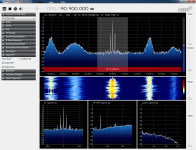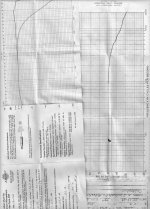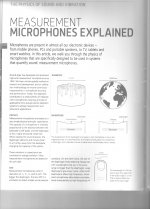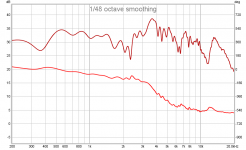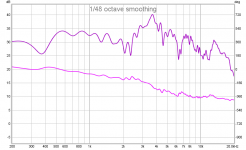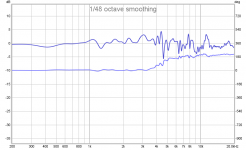John- Its just a matter of time. I'll have some pulled out next week. I can lend you a 2609 measuring amp to play with as well (I have 2).
An expensive mic and still have 0.2-0.3% distortion or .35% THd. Hmmm. I would have to wonder that any lower quality mic would have higher distortion?
But, then there is PMA's mic at 10 times lower distortion. How much does that one cost?
THx-RNMarsh
But, then there is PMA's mic at 10 times lower distortion. How much does that one cost?
THx-RNMarsh
Richard, are you talking about MY mike? The residual distortion is in the K-horn speaker. Look at the SPL's. Your horn speaker would measure somewhat better, because it has a bigger driver diameter, and a redesigned driver with less inherent throat distortion. You have to trust that a Class A based system operates in predictable way. For the record, the K-horn above 400Hz uses a 1/2" diameter Atlas 'ballpark' driver with Klipsch's (fairly OK midrange horn). For the record, a 1" throat JBL LE-85, at 2W input, (about 110SPL) measured about 3% 2'nd harmonic distortion at 1KHz with the same mike.
Last edited:
You are quite dapper in your new clothes.I recently have been trying to give serious advice, instead of just negative comments.
I certainly appreciate your recent posts, thank you.
jn
Good measurement mics are not cheap, and this is diy

BTW guys this is DIY with an attempt to be accessible to as many as possible.

I know senior EE's that retired and bought $50K Aglient spectrum analyzers to tune up their ham rigs.
If you’ll develop an itch, today’s alternative can go anywhere from $20 to $2K.
An HF/VHF/UHF RTL-SDR AM/FM/SSB/DSB Receiver in USB memory stick size and a free SDR receiver software
George
Attachments
Scott, I understand that you have close experience of Panasonic electret mic capsules.
Did you do statistical comparisons between samples to gain averages, and did you compare with known references (B&K etc) ?.
If so what did you find, and by what measures ?.
Dan.
Did you do statistical comparisons between samples to gain averages, and did you compare with known references (B&K etc) ?.
If so what did you find, and by what measures ?.
Dan.
George, I can always count on you. Thanks.There is a block diagram for the FX (1st link, page 3). It maybe the same architecture with the USB
The 4th link is a Quick Start Guide for the USB
https://www.fullcompass.com/common/files/7843-XENYX2222FXSpecificationSheet.pdf
http://www.giantsound.hu/files/1622_1832_2222_2442_fx.pdf
https://media.music-group.com/media/PLM/data/docs/P0A0M/X1622USB_X1832USB_X2222USB_X2442USB_M_EN.pdf
https://www.parts-express.com/pedocs/more-info/248-6608-behringer-xenyx-x2222usb--41356.pdf
Have fun 🙂
George
With luck, it is the same block. Once the hardware arrives, I will test all the I/O's to verify that the fx block is consistent with the USB.
I have an unused 21 inch iMac, and was thinking about building a travel case that holds the mixer, two Lepai amps, and the iMac in the lid such that it opens up ready for use..That would also solve the dvd/cd separate hardware source issue, I would preload video or audio I need for a gig as well as allow the recording software to follow me. With luck, it won't get too heavy.. I may have to do the old vacuum bagging with carbon fiber cloth/epoxy and titanium rib trick to keep the case weight down..I watched some "how it's made" episodes where they made boat hulls and airplane black box cases, so now I must be an "expert", no??
Hobbies are so much fun. Thankfully, I don't do this for pay, then it might become "work"..
jn
Last edited:
then it might become "work"..
"work"..
"work"..
"work"..
(just follow the beat) 🙂
P.S. Titanium + CFRP is OK for your Samsonite Audio Center (you’ll find titanium riveted patch over CFRP in modern airplanes as an approved repair).
George
It's actually not priced that badly. Online metals has .035" grade 2, 1 inch wide by 30 inches long for about 14 dollars. A couple those would be great stiffeners."work"..
"work"..
"work"..
(just follow the beat) 🙂
P.S. Titanium + CFRP is OK for your Samsonite Audio Center (you’ll find titanium riveted patch over CFRP in modern airplanes as an approved repair).
George
"Samsonite audio center"..😀 sigh, time to clean the keyboard...I really need to stop drinking coffee at the computer...
jn
The mixer I borrowed was in one of those typical carpeted cases, 3/4 thick wood (my guess) (may even be particle board), heavy sob..used to be my speakers were the heaviest thing to carry..
Scott, I understand that you have close experience of Panasonic electret mic capsules.
Did you do statistical comparisons between samples to gain averages, and did you compare with known references (B&K etc) ?.
If so what did you find, and by what measures ?.
I only played with the cheap FET included capsules out of curiosity (IIRC Panasonic is no longer making them). They are noisy, simply physics at play and the peak in the response is not extremely consistent but they are fairly flat and with cal are OK to measure level for DIY use. They are available calibrated from lots of folks BTW Dayton has the cal files on line for there cheap measurement mics, I made up some serial numbers and checked a few and there are several dB differences unit to unit. I have no idea how they age or hold a cal but the best pro measurement mics are made to stay calibrated by design (to sometimes absurd level) and cost $$.
You would be surprised at how many mics are based on these capsules.
Richard, I would predict that the distortion in my microphone at a given SPL would be the same at 100Hz, 1KHz or even 5KHz would be almost the same, due to the way the condenser mike works. It operates BELOW resonance primarily, (7.5KHz) and therefore should be the same amplitude of movement at all frequencies in this region. The follower was independently calibrated by me, when I remove the capsule and drive it from a 50pf cap. It is better than a typical fet follower, because I selected the current source fet for minimum distortion (it matters for some reason) AND I can selectively REDUCE THE 200V capsule bias voltage to anything down to 0V. Therefore I can maintain essentially the same output voltage at all reasonable SPL levels.
The only potential problem would be if I used the optional transformer output. However, the transformer used is much larger than any handheld mike could fit, so its effect would be minimal, if it were necessary to use it.
The only potential problem would be if I used the optional transformer output. However, the transformer used is much larger than any handheld mike could fit, so its effect would be minimal, if it were necessary to use it.
Attachments
Last edited:
Here is a link that is easier to read https://www.bksv.com/en/about/waves/WavesArticles/2018/Measurement-microphones-explained
Thanks Demian, this should clear some things up. By the way, how did you get this link? I had to scan my B&K news magazine.
I made an LTspice jig to synthesize an N-wave based on the first null frequency. If I need to I can try to remove the nulls this way.
This doesn't seem to be necessary for the taser after I reduced the spark gap to 3.5mm. But the generator noise still prevents me from using it. A metal screen in front of the microphone does seem to help with statically coupled noise though.
The other sparker has a shroud around the spark that I suspect is messing with the response.
BTW, here is the original thread on the spark calibration:
https://www.diyaudio.com/forums/solid-state/145585-calibrating-microphones-speakers.html#post1850258
This doesn't seem to be necessary for the taser after I reduced the spark gap to 3.5mm. But the generator noise still prevents me from using it. A metal screen in front of the microphone does seem to help with statically coupled noise though.
The other sparker has a shroud around the spark that I suspect is messing with the response.
BTW, here is the original thread on the spark calibration:
https://www.diyaudio.com/forums/solid-state/145585-calibrating-microphones-speakers.html#post1850258
JC... OK. at 100db spl, the thd will be under 0.1 % THD. I can use that then. So, how much does your mic cost w/preamp?
How much is a B&K 4190 mic plus its preamp?
Are there other mics which cost less than 4190 that are also low THD? Which are they?
THx-RNMarsh
How much is a B&K 4190 mic plus its preamp?
Are there other mics which cost less than 4190 that are also low THD? Which are they?
THx-RNMarsh
Richard, I built my mike system over 45 years ago. Today, you might have to pay $1000 on E-Bay to get similar performance from ACO, for a used unit. The most important thing is getting a properly made mike capsule. The rest is fairly simple. It's not cheap, but then you will have a dependable microphone that you can trust.
What's so strange is that there is almost no difference in measured frequency response when I invert the tweeter in the B652-AIR speakers I got. Just a change in absolute phase.
The hump at 3.5k seems to be my microphone. 3rd image is the difference
The hump at 3.5k seems to be my microphone. 3rd image is the difference
Attachments
Last edited:
- Status
- Not open for further replies.
- Home
- Member Areas
- The Lounge
- John Curl's Blowtorch preamplifier part III
